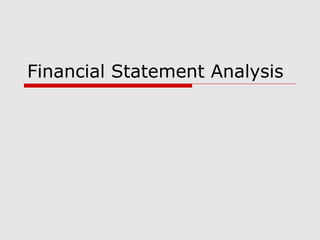
Financial statement analysis[1]
- 2. Rationale of Financial Statement Analysis Financial statement – summary of figures as of any given date To identify relevant information Draw meaningful interpretations
- 3. Process of Analysis Identification of significant information Highlight significant relationships Interpretation
- 4. Tools of Financial Analysis Fund flow Statement Cash Flow Statement Ratio Analysis Common size statements
- 5. Balance Sheet Overview- ASSETS Assets Gross Block 3978.55 Net Block 2790.57 Capital WIP 66.72 Investments 454.33 Inventory 610.81 Receivables 1546.81 Other Current Assets 3673.67 Balance Sheet Total 9142.92
- 6. Balance Sheet Overview- Liabilities Liabilities Equity Share Capital 434.12 Reserves 5815.65 Total Debt 2096.69 Creditors and Acceptances 393.91 Other current liab/prov. 402.55 Balance Sheet Total 9142.92
- 7. Ratio Analysis Most widely used and significant tool Provides a basis for comparison Useful when benchmark ratios are known Relationships between variables in the financial statement
- 8. Types of ratios Liquidity ratios Capital Structure ratios Profitability Ratios Activity/Efficiency ratios Integrated Analysis of ratios Growth ratios
- 9. Overview of Balance Sheet LIABILITIES Equity Capital/Owners’ Funds Long Term Borrowings Current Liabilities ASSETS Fixed Assets Current Assets
- 10. Liquidity Ratios Measure the ability of firm to meet short term obligations Reflect short term financial strength Why short term??- of interest to creditors.. Ratios- Current ratio, Liquid ratio, Turnover ratios, cash flow from operation ratio
- 11. Liquidity ratios Current Ratio= Current Assets/ Current Liabilities Liquid ratio= Liquid Assets/Current Liabilities
- 12. NEED FOR LIQUIDITY Assume stocks are bought on credit Converted to inventory Sales=0 Current Ratio?? Liquid Ratio?? Implications on liquidity-serious
- 13. ACTIVITY 1 Calculate Current Ratio, Liquid ratio, Debtors Turnover and Creditors turnover from the following information Average Debtors=1,00,000 Average Creditors=75,000 Cash= 5,000 Inventory=75,000 Credit Purchases=6,00,000 Credit Sales=12,00,000
- 14. Capital Structure ratios Helps to measure long term financial strength Solvency of the firm Ability to service interest on loans Ability to service the principal
- 15. Capital Structure Ratios Debt Equity ratio= Long Term Debt/Shareholders Equity Debt to total Capital= Total Debt/Total Assets Interest Coverage Ratio= Earnings Before Interest and Tax/Interest
- 16. ACTIVITY 2 What happens when a firm is purely funded by equity? What happens when a firm is purely funded by debt? Which is riskier when profits are less? When equity is high and profits are high, what happens to ROI?
- 17. Profitability ratios Related to Sales Ability of the firm to mark up on sales Ability of firm to convert margins to profit Proportion of expense to income Analysis of income and expenses
- 18. Profitability ratios Gross Profit Margin= Gross profit/Sales*100 Operating Profit ratio= Earnings Before Interest and taxes/Net Sales Net Profit Ratio= Earnings after interest and taxes/Net Sales Expenses ratio- Cost of Goods sold, Operating Ratio, Financial Expenses
- 19. Ratios on Investments Related to investment Ability to generate return on investment Ultimate measure of profitability Ability of firm to generate wealth
- 20. Profitability on Investment Return on Assets= Profit after Taxes/Average total assets*100 Return on Capital Employed= EBIT/Average Total Capital Employed*100 Return on Shareholders Equity= Net profit after taxes/Average shareholders’ equity*100
- 21. ACTIVITY 3 Earnings Before Interest and Tax= Rs.5,00,000 Interest payment =Rs.75,000 Tax rate = 50% Calculate Earnings after Interest and tax
- 22. Profitability on investment Earnings per share=Net Profit available to Equity Shareholders/Number of ordinary shares outstanding Price earning ratio= Market price of share/EPS
- 23. ACTIVITY 4 Calculate Gross Profit Margin and Net profit Margin Sales 2,00,000 Cost of Goods Sold 1,00,000 Other operating expenses 50,000
- 24. ACTIVITY 5 Calculate Return on Assets Current Assets 4,00,000 Fixed Assets 6,00,000 Net Profit before taxes 2,50,000 Tax rate 50%
- 25. Activity Ratios Concerned with measuring the efficiency Also the asset utilisation Rate at which assets are converted into sales Test of relationship of sales to various assets of the firm
- 26. Activity Ratios Turnover ratios Inventory turnover=Cost of Goods Sold/Average Inventory Debtors turnover=Net Credit Sales/Average Debtors Creditors turnover=Net Credit Purchases/Average creditors Assets Turnover=Cost of Goods sold/Average total assets
- 27. Activity ratios Turnover refers to the number of times the asset turned over Does faster turnover mean efficiency? What does a slow turnover of inventory mean? Should inventory turnover be homogenous across industries?
- 28. ACTIVITY 6 In which industries inventory turnover is irrelevant? Which industries have seasonal turnover of inventory? Which are the industries where turnover is not rapid? When will the Debtor Turnover be irrelevant?
- 29. Integrated Analysis of ratios To understand the interrelationship of ratios Operating efficiency-combination of various factors Tests the earning power of the firm
- 30. Integrated Analysis Earning Power= EAT/Sales*Sales/Assets*Assets/Equit y
- 31. Growth ratios Growth that can be sustained without external funding Earnings that are retained and reinvested within the firm The two common measures used are Internal Growth rate-without raising funds Sustainable growth rate- Without altering Debt Equity ratio
- 32. ACTIVITY 7 Which ratios will you look for when you want to invest in a firm Which are the ratios a banker will look for? Which ratios are relevant from the point of view of revenue? Which ratios are relevant if a supplier is contemplating to give credit to a firm?
- 33. What you must remember while calculating ratios Nature of Industry-Service, Seasonal, Heavy Engineering, Infrastructure.. Age of the firm Industry benchmark Peculiarities in the business Risk Factors
- 34. Importance of ratio Anlaysis Liquidity Solvency Operating efficiency Overall Profitability Interfirm Comparison Trend Analysis
- 35. Limitations of ratio Analysis Individual accounting variations Impact of inflation Conceptual diversity Only quantifiable inputs can be evaluated
